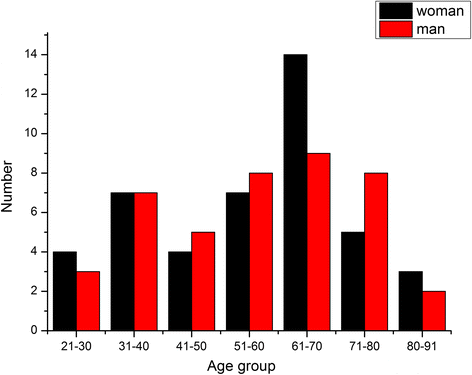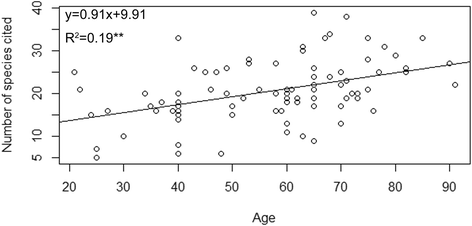Traditional knowledge and its transmission of wild edibles used by the Naxi in Baidi Village, northwest Yunnan province
- PMID: 26846564
- PMCID: PMC4743116
- DOI: 10.1186/s13002-016-0082-2
Traditional knowledge and its transmission of wild edibles used by the Naxi in Baidi Village, northwest Yunnan province
Abstract
Background: The collection and consumption of wild edibles is an important part in livelihood strategies throughout the world. There is an urgent need to document and safeguard the wild food knowledge, especially in remote areas. The aims of this study are to accomplish detailed investigation of wild edibles used by the Naxi in Baidi village and evaluate them to identify innovative organic food products. Also, we aim to explore the characteristics of distribution and transmission of the traditional knowledge (TK) on wild edibles among the Naxi.
Methods: Data was collected through a semi-structured interview of key informants above the age of 20 years, chosen carefully by a snowball sampling. The interviews were supplemented by free lists and participatory observation methods. Informants below 20 years were interviewed to test their knowledge of traditional practices. A quantitative index like Cultural Importance Index (CI) was used to evaluate the relative importance of the different wild edibles. Linear regression and t-test were performed to test variation in the TK among the informants of different age groups and genders.
Results: Altogether 173 wild edible plant species belonging to 76 families and 139 genera were recorded in the study. Cardamine macrophylla, C. tangutorum and Eutrema yunnanense, have traditionally been consumed as an important supplement to the diet, particularly during food shortages as wild vegetables. The age was found to have a significant effect on TK, but there was no significant difference between male and female informant in knowledge abundance. The traditional food knowledge was dynamic and affected by social factors. Also, it was descending partly among younger generations in Baidi.
Conclusion: Baidi village is a prime example of a rapidly changing community where local traditions compete with modern ways of life. Overall, this study provides a deeper understanding of the Naxi peoples' knowledge on wild edibles. Some wild edibles might have an interesting dietary constituent, which need in-depth studies. Such detail studies can help to promote the market in one hand and protect TK in the other. Protecting TK from disappearing in succeeding generations is necessary, and understanding the dynamics of TK is one important solution to this dilemma.
Figures






Similar articles
-
Ethnobotanical study of traditional edible plants used by the Naxi people during droughts.J Ethnobiol Ethnomed. 2016 Sep 12;12(1):39. doi: 10.1186/s13002-016-0113-z. J Ethnobiol Ethnomed. 2016. PMID: 27619157 Free PMC article.
-
Ethnobotanical survey of medicinal dietary plants used by the Naxi People in Lijiang Area, Northwest Yunnan, China.J Ethnobiol Ethnomed. 2015 May 12;11:40. doi: 10.1186/s13002-015-0030-6. J Ethnobiol Ethnomed. 2015. PMID: 25962397 Free PMC article.
-
Monpa, memory, and change: an ethnobotanical study of plant use in Mêdog County, South-east Tibet, China.J Ethnobiol Ethnomed. 2020 Jan 30;16(1):5. doi: 10.1186/s13002-020-0355-7. J Ethnobiol Ethnomed. 2020. PMID: 32000826 Free PMC article.
-
Food for two seasons: culinary uses of non-cultivated local vegetables and mushrooms in a south Italian village.Int J Food Sci Nutr. 2005 Jun;56(4):245-72. doi: 10.1080/09637480500146564. Int J Food Sci Nutr. 2005. PMID: 16096136 Review.
-
Not just minor wild edible forest products: consumption of pteridophytes in sub-Saharan Africa.J Ethnobiol Ethnomed. 2014 Dec 22;10:78. doi: 10.1186/1746-4269-10-78. J Ethnobiol Ethnomed. 2014. PMID: 25534561 Free PMC article. Review.
Cited by
-
Composition of Essential Oils from Roots and Aerial Parts of Carpesium divaricatum, a Traditional Herbal Medicine and Wild Edible Plant from South-East Asia, Grown in Poland.Molecules. 2019 Dec 3;24(23):4418. doi: 10.3390/molecules24234418. Molecules. 2019. PMID: 31816933 Free PMC article.
-
The nexus between ecology of foraging and food security: cross-cultural perceptions of wild food plants in Kashmir Himalaya.J Ethnobiol Ethnomed. 2024 Aug 18;20(1):77. doi: 10.1186/s13002-024-00721-9. J Ethnobiol Ethnomed. 2024. PMID: 39155383 Free PMC article.
-
Wild edible plants of the Yao people in Jianghua, China: plant-associated traditional knowledge and practice vital for food security and ecosystem service.J Ethnobiol Ethnomed. 2024 Aug 28;20(1):80. doi: 10.1186/s13002-024-00724-6. J Ethnobiol Ethnomed. 2024. PMID: 39198831 Free PMC article.
-
Composition of Essential Oils from Roots and Aerial Parts of Carpesium cernuum and Their Antibacterial and Cytotoxic Activities.Molecules. 2021 Mar 26;26(7):1883. doi: 10.3390/molecules26071883. Molecules. 2021. PMID: 33810440 Free PMC article.
-
Ethnobotanical study of traditional edible plants used by the Naxi people during droughts.J Ethnobiol Ethnomed. 2016 Sep 12;12(1):39. doi: 10.1186/s13002-016-0113-z. J Ethnobiol Ethnomed. 2016. PMID: 27619157 Free PMC article.
References
-
- Lulekal E, Asfaw Z, Kelbessa E, Van Damme P. Wild edible plants in Ethiopia: a review on their potential to combat food insecurity. Afr Focus. 2011;24:71–121.
-
- Cunningham AB. Applied ethnobotany. People, wild plant use and conservation. 1 publth edition. London: Earthscan; 2001.
-
- Pardo-de-Santayana M, Tardío J, Blanco E, Carvalho AM, Lastra JJ, San Miguel E, et al. Traditional knowledge of wild edible plants used in the northwest of the Iberian Peninsula (Spain and Portugal): a comparative study. J Ethnobiol Ethnomed. 2007;3:27. doi: 10.1186/1746-4269-3-27. - DOI - PMC - PubMed
Publication types
MeSH terms
LinkOut - more resources
Full Text Sources
Other Literature Sources

